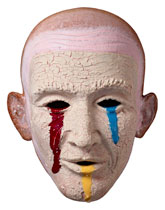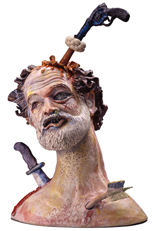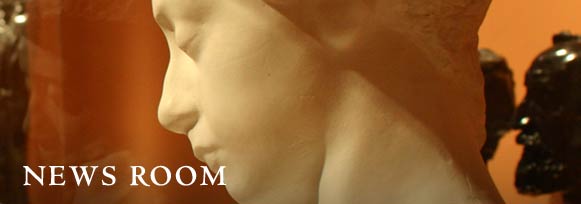Irreverent Sculptor Broke Boundaries, Transformed Clay from “Craft” to “High Art”
Fatal Laughs: The Art of Robert Arneson
August 20, 2014–September 28, 2015
Stanford, Calif. — American sculptor Robert Arneson (1930–1992) revolutionized the medium of clay, transforming it from a “craft” into “fine art.” For more than 40 years, frequently using himself as a subject, he explored controversial ideas outside the conventional art repertory, including many that were sexual, racial or political in nature. “I want to make high art that is funny, outrageous and also reveals the human condition, which is not always high,” he once said.
The Cantor Arts Center at Stanford University presents an exhibition of some of Arneson’s most acclaimed works. Fatal Laughs: The Art of Robert Arneson, running August 20, 2014 through September 28, 2015, features the 1964 Funk object His and Hers, which irreverently explores sexual and scatological subject matter while also considering the traditional function of ceramics; in two works from the 1970s, Assassination of a Famous Nut Artist and Flip and Flop, the artist’s image is a vehicle for anguish and pain; in the works from the 1980s, including Global Death and Destruction, Arneson proves that clay is a powerful way to voice political views.
Arneson spent his entire life in the Bay Area. He was born just east of San Francisco Bay in Benecia, studied at the California College of Arts and Crafts and earned a master's degree in 1958 from Mills College. After teaching stints at Santa Rosa Junior College, Fremont High School and Mills College, Arneson began a momentous three-decade academic career at UC Davis in 1962.
While at UC Davis, Arneson led a movement that took ceramic art in a new direction. When Arneson came to campus, ceramic art forms were mainly versions of traditional pottery shapes: pots, vases, plates and tiles. Arneson and others abandoned the manufacture of functional wares in favor of using everyday objects to make confrontational statements. The new movement was dubbed "Funk Art," and Arneson is considered the "father of the ceramic Funk movement." He battled cancer in the last decade of his life, and died in 1992.
Arneson’s works can be found in public and private collections around the world, including: the Smithsonian American Art Museum and the Hirshhorn Museum in Washington, D.C.; the Whitney Museum of American Art and the Metropolitan Museum of Art in New York; the Chicago Art Institute; and the Museum of Contemporary Art in Kyoto, Japan. In addition to the Cantor, the Anderson Collection at Stanford University and the San Francisco Museum of Modern Art are among Bay Area institutions that hold works by Arneson.
Four of the works in this exhibition are from the Cantor Arts Center collection; Flip and Flop is lent from the Collection of Paula and Ross Turk, and Wolf Head is on loan from the estate of Robert Arneson, courtesy of Brian Gross Fine Art, San Francisco and George Adams Gallery, New York. The exhibition is made possible by support from the Contemporary Collectors Circle.
Checklist for Fatal Laughs: The Art of Robert Arneson
• Assassination of a Famous Nut Artist, 1971. Whiteware with glazes, 30 x 22 x 13 inches. Cantor Arts Center Collection, Museum purchase made possible by the Robert and Ruth Halperin Foundation, 2008.1.a-b
• Flip and Flop, 1978. Polychrome glazed earthenware, two elements 28 x 19 x 19 inches (each). Lent by Collection of Paula and Ross Turk
• Global Death and Destruction, 1982–83. Stoneware with glazes, 74-1/2 x 26 x 25 inches. Cantor Arts Center Collection, Gift of Ross and Paula Turk and the Modern and Contemporary Art Fund, 2000.261.a-b
• His and Hers, 1964. Stoneware with overglaze, 34 x 24 x 28 inches. Cantor Arts Center Collection, Museum purchase from the Modern and Contemporary Art Fund, and funds realized through the deaccession and sale of gifts from several generous donors, 2007.35.a-d
• Primary Discharge, 1990, 15 x 12 x 7 inches. Earthenware and glaze. Cantor Arts Center Collection, Given in memory of Professor A. L. Schawlow by John F. and Barbara L. Holzrichter, 2009.75
• Wolf Head, 1989. Bronze and wood, 83 x 73 x 76 inches. Estate of Robert Arneson courtesy of Brian Gross Fine Art, San Francisco and George Adams Gallery, New York.
Related Exhibitions
The Cantor presents three other new exhibitions of contemporary art, in addition to Fatal Laughs:
• Pop Art from the Anderson Collection at SFMOMA (through October 26, 2015) features 10 groundbreaking works by Pop Art’s biggest names: Jim Dine (U.S.A., b. 1935), Robert Indiana (U.S.A., b. 1928), Jasper Johns (U.S.A., b. 1930), Roy Lichtenstein (U.S.A., 1923–1997), Claes Oldenburg (b. Sweden, 1929), Robert Rauschenberg (U.S.A., 1925–2008), James Rosenquist (U.S.A., b. 1933) and Andy Warhol (U.S.A., 1928–1987).
• Bay Area and Beyond: Selections from the Museum’s Collection (through October 26, 2015) includes works by artists who established the Bay Area Figurative Movement and who have ties to Stanford: Richard Diebenkorn (U.S.A., 1922–1993), Nathan Oliveira (U.S.A., 1928–2010), Frank Lobdell (U.S.A., 1921–2013) and others.
• Well Pressed: Highlights from the Marmor Collection (through February 2, 2015) consists of objects given to the Cantor by the Marmor Foundation and includes early and late works by Jasper Johns (U.S.A., b. 1930), unconventional approaches to the print process by Roy Lichtenstein (U.S.A., 1923–1997) and Claes Oldenburg (b. Sweden, 1929), and representative lithographs by Ellsworth Kelly (U.S.A., b. 1923), Richard Serra (U.S.A., b. 1939) and Frank Stella (U.S.A., b. 1936).
Cantor Arts Center
The Cantor Arts Center at Stanford University is a vital and dynamic institution with a venerable history. Founded in 1891 with the university, the historic museum was expanded and renamed in 1999 for lead donors Iris and B. Gerald Cantor. The Cantor’s encyclopedic collection spans 5,000 years, includes more than 40,000 artworks and beckons visitors to travel around the world and through time: from Africa to the Americas to Asia, from classical to contemporary. With 24 galleries presenting selections from the collection and more than 20 special exhibitions each year, the Cantor serves Stanford’s academic community, draws art lovers from the San Francisco Bay Area and beyond and attracts campus visitors from around the world. Free admission, free tours, lectures, family activities plus changing exhibitions make the Cantor one of the most well-attended university art museums in the country and a great resource for teaching and research on campus.
Visitor Information
The Cantor Arts Center is open Wednesday–Sunday, 11 a.m.–5 p.m., Thursday until 8 p.m. Beginning September 22, the Cantor will also be open on Mondays from 11 a.m. to 5 p.m. Admission is free. The Cantor is located on the Stanford campus, off Palm Drive at Museum Way. Parking is free after 4 p.m. weekdays and all day on weekends and major holidays. Information: 650-723-4177, museum.stanford.edu.
# # #
Notes to Editors
• To arrange an interview or obtain an exhibition checklist, contact Anna Koster, Head of Communications, Cantor Arts Center, 650-725-4657, akoster@stanford.edu
• For high-resolution publicity images, contact PR Assistant Manager Margaret Whitehorn, Cantor Arts Center, 650-724-3600, mmwhite@stanford.edu

Robert Arneson (U.S.A., 1930–1992), Primary Discharge, 1990. Earthenware and glaze. Cantor Arts Center Collection, Given in Memory of Professor A. L. Schawlow by John F. and Barbara L. Holzrichter, 2009.75. © Estate of Robert Arneson/Licensed by VAGA, New York, NY.

Robert Arneson (U.S.A., 1930–1992), Assassination of a Famous Nut Artist, 1971. Whiteware with glazes. Museum purchase made possible by the Robert and Ruth Halperin Foundation, 2008.1.a–b. © Estate of Robert Arneson/Licensed by VAGA, New York, NY.



